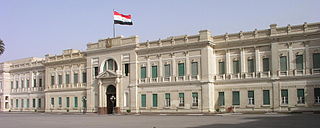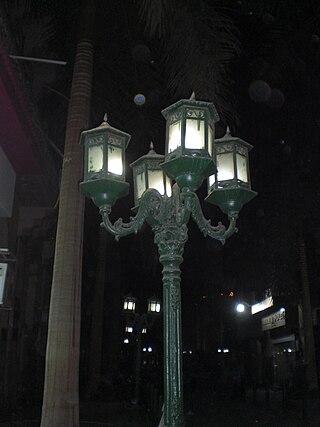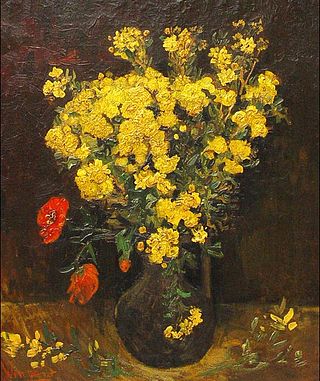
Cairo is the capital and largest city of Egypt and the Cairo Governorate, being home to more than 10 million people. It is also part of the largest urban agglomeration in Africa, the Arab world and the Middle East. The Greater Cairo metropolitan area is the 12th-largest in the world by population with over 22.1 million people.

Naguib Mahfouz Abdelaziz Ibrahim Ahmed Al-Basha was an Egyptian writer who won the 1988 Nobel Prize in Literature. In awarding the prize, the Swedish Academy described him as a writer "who, through works rich in nuance – now clear-sightedly realistic, now evocatively ambiguous – has formed an Arabian narrative art that applies to all mankind". Mahfouz is regarded as one of the first contemporary writers in Arabic literature, along with Taha Hussein, to explore themes of existentialism. He is the only Egyptian to win the Nobel Prize in Literature. He published 35 novels, over 350 short stories, 26 screenplays, hundreds of op-ed columns for Egyptian newspapers, and seven plays over a 70-year career, from the 1930s until 2004. All of his novels take place in Egypt, and always mention the lane which equals the world. His most famous works include The Cairo Trilogy and Children of Gebelawi. Many of Mahfouz's works have been made into Egyptian and foreign films; no Arab writer exceeds Mahfouz in number of works that have been adapted for cinema and television. While Mahfouz's literature is classified as realist literature, existential themes appear in it.

Nefertiti was a queen of the 18th Dynasty of Ancient Egypt, the great royal wife of Pharaoh Akhenaten. Nefertiti and her husband were known for their radical overhaul of state religious policy, in which they promoted the earliest known form of monotheism, Atenism, centered on the sun disc and its direct connection to the royal household. With her husband, she reigned at what was arguably the wealthiest period of ancient Egyptian history. After her husband's death, some scholars believe that Nefertiti ruled briefly as the female pharaoh known by the throne name, Neferneferuaten and before the ascension of Tutankhamun, although this identification is a matter of ongoing debate. If Nefertiti did rule as pharaoh, her reign was marked by the fall of Amarna and relocation of the capital back to the traditional city of Thebes.

The Museum of Egyptian Antiquities, commonly known as the Egyptian Museum, located in Cairo, Egypt, houses the largest collection of Egyptian antiquities in the world. It houses over 120,000 items, with a representative amount on display. Located in Tahrir Square in a building built in 1901, it is the largest museum in Africa. Among its masterpieces are Pharaoh Tutankhamun's treasure, including its iconic gold burial mask, widely considered one of the best-known works of art in the world and a prominent symbol of ancient Egypt.

Zahi Abass Hawass is an Egyptian archaeologist, Egyptologist, and former Minister of Tourism and Antiquities, a position he served twice in. He has worked at archaeological sites in the Nile Delta, the Western Desert and the Upper Nile Valley.
Cairo is the capital city of Egypt.

Egyptian Revival is an architectural style that uses the motifs and imagery of ancient Egypt. It is attributed generally to the public awareness of ancient Egyptian monuments generated by Napoleon's invasion of Egypt in 1798, and Admiral Nelson's defeat of the French Navy at the Battle of the Nile later that year. Napoleon took a scientific expedition with him to Egypt. Publication of the expedition's work, the Description de l'Égypte, began in 1809 and was published as a series through 1826. The size and monumentality of the façades discovered during his adventure cemented the hold of Egyptian aesthetics on the Parisian elite. However, works of art and architecture in the Egyptian style had been made or built occasionally on the European continent since the time of the Renaissance.

Abdeen District is the home of Abdeen Palace, a 19th-century Cairo palace built by Khedive Ismail and served as the Egyptian royal household's primary official residence from 1874 until the July Revolution in 1952. Since then it has been of the presidential palaces. The palace is centered in its eponymous district, administratively part of the Western Area of Cairo, and part of the Khedival Cairo Area of Value to the west of Historic Cairo.
Air Cairo is an airline based in Cairo, Egypt. The airline is part owned by Egyptair. Air Cairo operates scheduled flights to the Middle East and Europe and also operates charter flights to Egypt from Europe on behalf of tour operators. Its bases are Cairo International Airport, Sharm El Sheikh International Airport and Hurghada International Airport with the company head office located in the Sheraton Heliopolis Zone.
Museum of Islamic Art may refer to:
Ramses Wissa Wassef (1911–1974) was an Egyptian architect and professor of art and architecture at the College of Fine Arts in Cairo and founder of the Ramses Wissa Wassef Art Centre.

Boulaq, is a district of Cairo, in Egypt. It neighbours Downtown Cairo, Azbakeya, and the River Nile.
Tourism is one of the leading sources of income, crucial to Egypt's economy. At its peak in 2010, the sector employed about 12% of workforce of Egypt, serving approximately 14.7 million visitors to Egypt, and providing revenues of nearly $12.5 billion as well as contributing more than 11% of GDP and 14.4% of foreign currency revenues.

George Abdel Masih Al Bahgoury or George Bahgoury is an Egyptian-French artist. An accomplished painter and sculptor, he is most famous as a caricaturist and political cartoonist.

Qasr El Nil Street, is a street in downtown Cairo, Egypt, one of the biggest streets in Cairo, with many businesses, restaurants, and an active nightlife.

Poppy Flowers is a painting by Vincent van Gogh with an estimated value of US$55 million which was stolen from Cairo's Mohamed Mahmoud Khalil Museum twice; first in 1977, then again in August 2010 and has yet to be found.

Youssef Nabil was born on the 6th of November 1972. He is an Egyptian artist and photographer. Youssef Nabil began his photography career in 1992.

Our Lady of Warraq is believed, by some, to be a mass apparition of the Virgin Mary that occurred at the Coptic Orthodox Virgin Mary and Archangel Michael church, in Warraq al-Hadar, Giza, Egypt, in the early hours of Friday 11 December 2009.
Wael Shawky is an Egyptian artist working between Alexandria and Philadelphia. Shawky gained international recognition for his works that trace the history of the Crusades through a Middle Eastern lens. Shawky has won many awards and prizes for his work, including the Ernst Schering Foundation Art Award in 2011 and the Mario Merz Prize (2015) for his film trilogy, Al Araba Al Madfuna. He is represented by Sfeir-Semler Gallery, Galleria Lia Rumma and Lisson Gallery.












